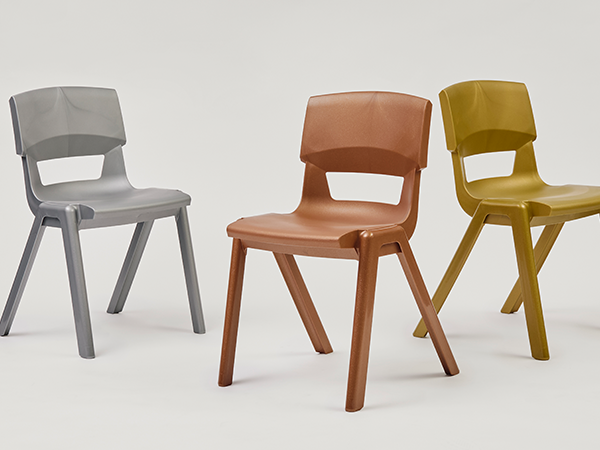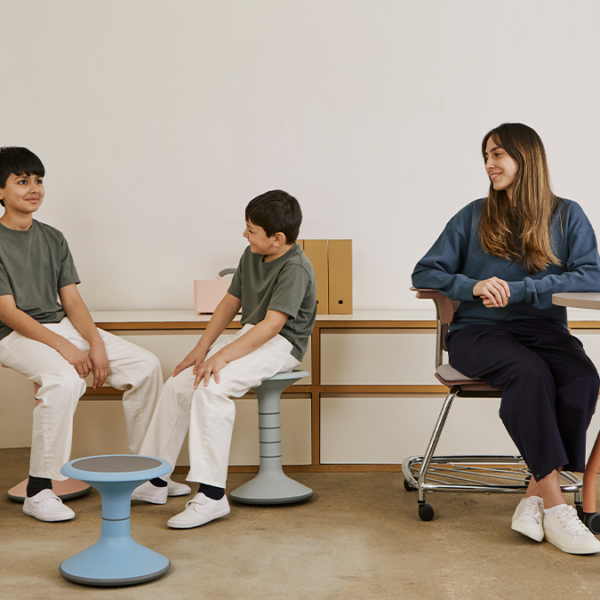Flexible Seating in Classrooms: Benefits & Ideas
Old school, traditional classroom furniture comprised wooden chairs and desks, sometimes bolted together or even to the floor. One size fits all. It was rigid, fixed and positioned to face the authoritative teacher at the front of the classroom. Student differences weren’t factored into that equation.
But now, we appreciate student diversity better. We understand that students have different needs, preferences and ways of learning. Flexible seating supports those differences. Flexible seating provides students with options and lets them choose what works for them.
Learning environments should be designed to encourage student engagement and learning. A diversity of seating choices to suit different activities and/or students is one way to support this. Let’s explore what flexible seating looks like and the impact it can have on classroom management and student engagement.
What makes flexible furniture different to traditional chairs and desks found in schools?

Traditional chairs and desks are characterised by being hard (wooden, metal or plastic), static and rigid. In contrast, flexible seating (or alternative seating) can be soft, adjustable, movable and dynamic.
Flexible seating includes options like floor cushions, balance balls, bean bags, bean bag chairs, wobble chairs and stools, tilted stools and lap desks. You don’t always assign a chair to a desk. Some floor seating, for example, doesn’t need a desk. A student may read or work on a tablet from their beanbag or floor cushion.
How does flexible seating impact student engagement and learning?

Research into soft seating has highlighted various positive impacts on student engagement and learning. Adopting flexible types of seating can support students’ wellbeing and learning. Being more comfortable and supported helps with both mental and physical health. It can also aid focus and collaborative learning.
Flexible seating also supports different ways of teaching and student interaction. Classroom furniture can be moved around to form different seating arrangements to suit the learning activity. That could be as simple as stacking chairs to make more space for students to move around and engage in group activities.
Versatile learning spaces are more inclusive, catering to individual and group needs. This is particularly positive for neurodiverse students (spanning conditions including autism spectrum disorder, ADHD, dyspraxia and dyslexia).
Teachers are able to adapt the environment to suit the students or the planned activity. The seating arrangement for a small group activity can differ to that for teacher-led addresses. You may have a reading corner with beanbag chairs, floor cushions for circle time or PHSE discussions, and then task chairs or stools aligned with student desks for writing activities.
What are the benefits to students?

Empowerment: both teachers and students are empowered to make choices about seating options. Students can select the type of seating that suits them at that particular time. It’s worth noting that teaching students how to make seating choices is a big part of using flexible seating in your classroom. Some may find it overwhelming. There may be conflict if there isn’t enough of a certain type of seating at one time. But that’s part of the learning curve and teaches problem-solving skills too.
Comfort: ergonomic seating that supports your body well provides comfort and minimises aches and pains caused by seating that doesn’t suit your frame. When you’re comfortable and not distracted by pain or sensory distraction, you’re more able to learn, concentrate and engage.
Collaboration: flexible seating arrangements encourage group work and discussion. Being able to move furniture easily means that students can form groups, or spin around to talk to others quickly.
Adaptability: adjusting the classroom layout to suit the learning activity increases student engagement and participation.
Inclusivity: creating a space that works for diverse students with differing needs isn’t straightforward. But providing multiple seating options and versatile learning environments supports students’ differences.
8 of the best flexible seating options

Thinking of incorporating flexible seating into your classroom? Here are some of the different types of seating and their benefits to your diverse learners.
Wobble stool
Kids like to fidget! We’re not predisposed to sitting still for hours on end. That’s even more true if you have ADHD. But sitting and fidgeting don’t have to be distinct activities. Wobble chairs, wobble stools and rockers are designed to encourage movement. Students can sit, yet still wiggle and fidget. This helps to actively engage mind and body.
Our Ricochet wobble stool has been created to encourage active sitting – fidgeting and moving. It’s durable, appropriate for all ages and easy to move around the classroom.
Beanbag chair
Bean bags are super comfortable and can encourage students to relax instantly. That’s ideal for certain activities like reading, tablet work or small group discussions. The covers are usually easy to remove so that they can be washed.
Floor cushion
Some kids love a floor seat. There are various floor seats on the market and they can also be coupled with a lap desk for a great study set-up. But simple floor cushions can be used like beanbags, as soft seating options. Sensory cushions with different textures on the two sides can appeal to learners with sensory needs.
Balance ball
Often known as an exercise ball (or stability ball or yoga ball), a balance ball isn’t just beneficial in the gym. Like the wobble stool, the balance ball supports active sitting. It can help with posture and core stability. You can also pair it with a stand or seat structure to prevent it from rolling away.
Ergonomic task chair
Adjustability makes a huge difference to a student’s comfort. Being able to customise the seat height, back support, armrest and positioning to fit with your body will improve your posture and encourage better learning. Plus, being on wheels, they can be moved easily when required.
Our Ruckus task chair has been designed to encourage a personalised sitting experience. Its unique backrest also functions as an armrest, work surface, or even a perch.
High task stool
This is a popular, adjustable seat for teachers and older students in particular. It can work alongside a standing desk or IT workstation for example.
Our Postura+ task stool is the ideal choice for multi-purpose rooms where mobility is required.
Stacking chair
Stackable chairs make it easy to clear space in your learning environment. Students can quickly and simply move the chairs to one size to make room for certain activities.
Our Postura+ One Piece chair is our most popular student seating option. Easy to stack and clean, it’s the perfect addition to any dynamic learning environment.
Lounge seating
Swivel chairs are loved by students of all ages! With a gyroscopic motion, these chairs spin around 360 degrees while still remaining steady. They’re ideal for group discussion sessions.
Our Take5 Lounge seating is a fun, stylish solution for collaborative group work.
Case study
When Pebble Brook SEN School in Aylesbury wanted a seating solution that empowered their students with choice and ownership, they turned to us at KI Furniture. They chose the Ricochet wobble stool to complement their existing collection of Postura+ One Piece chairs.
“After trialling the product, the children simply couldn’t wait to use them properly. The colours are vibrant, they’re light enough to carry around, and they’re actually helping them to focus better.” Sarah Pitwell, Therapy Leader at Pebble Brook
Forward-thinking flexible seating options
We’re passionate about creating dynamic, inclusive learning spaces. We’ve worked with schools and colleges across the country to optimise their classroom layout with our products. We learn continuously from this collaborative work and use it to inform our designs.
Find out more about our school projects or browse our range of flexible student seatingrniture



